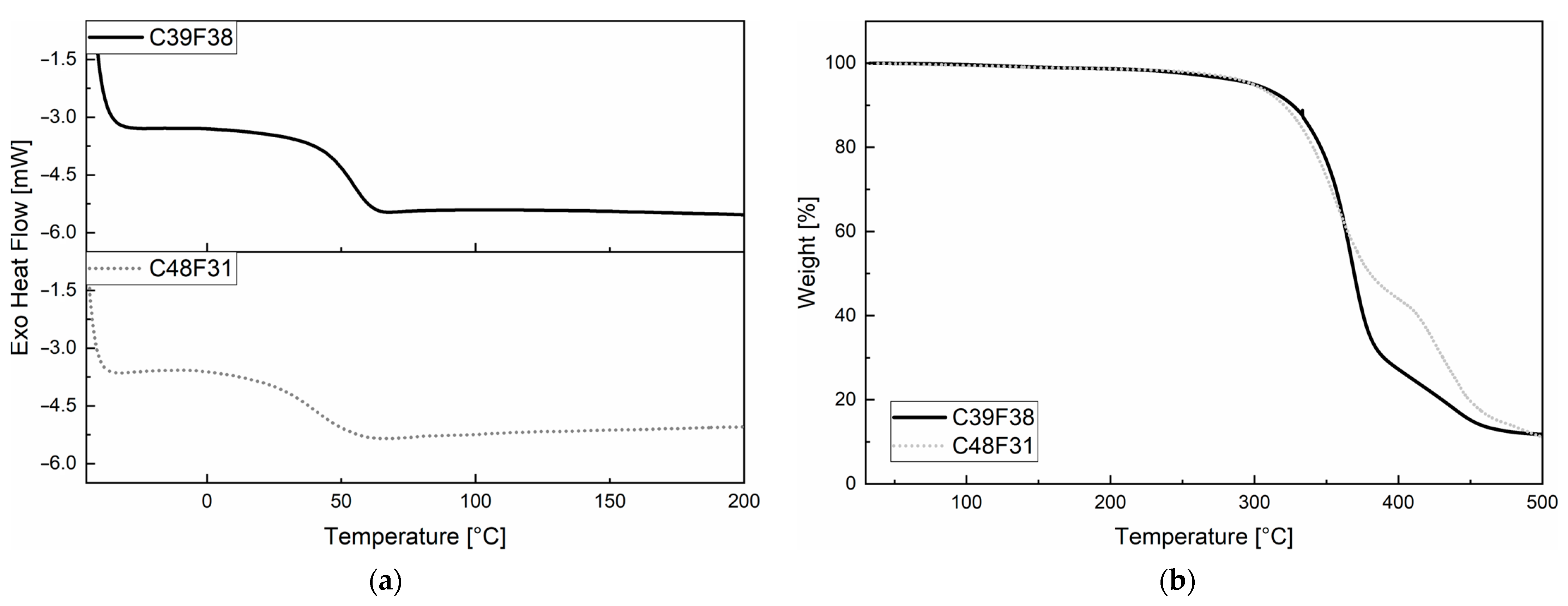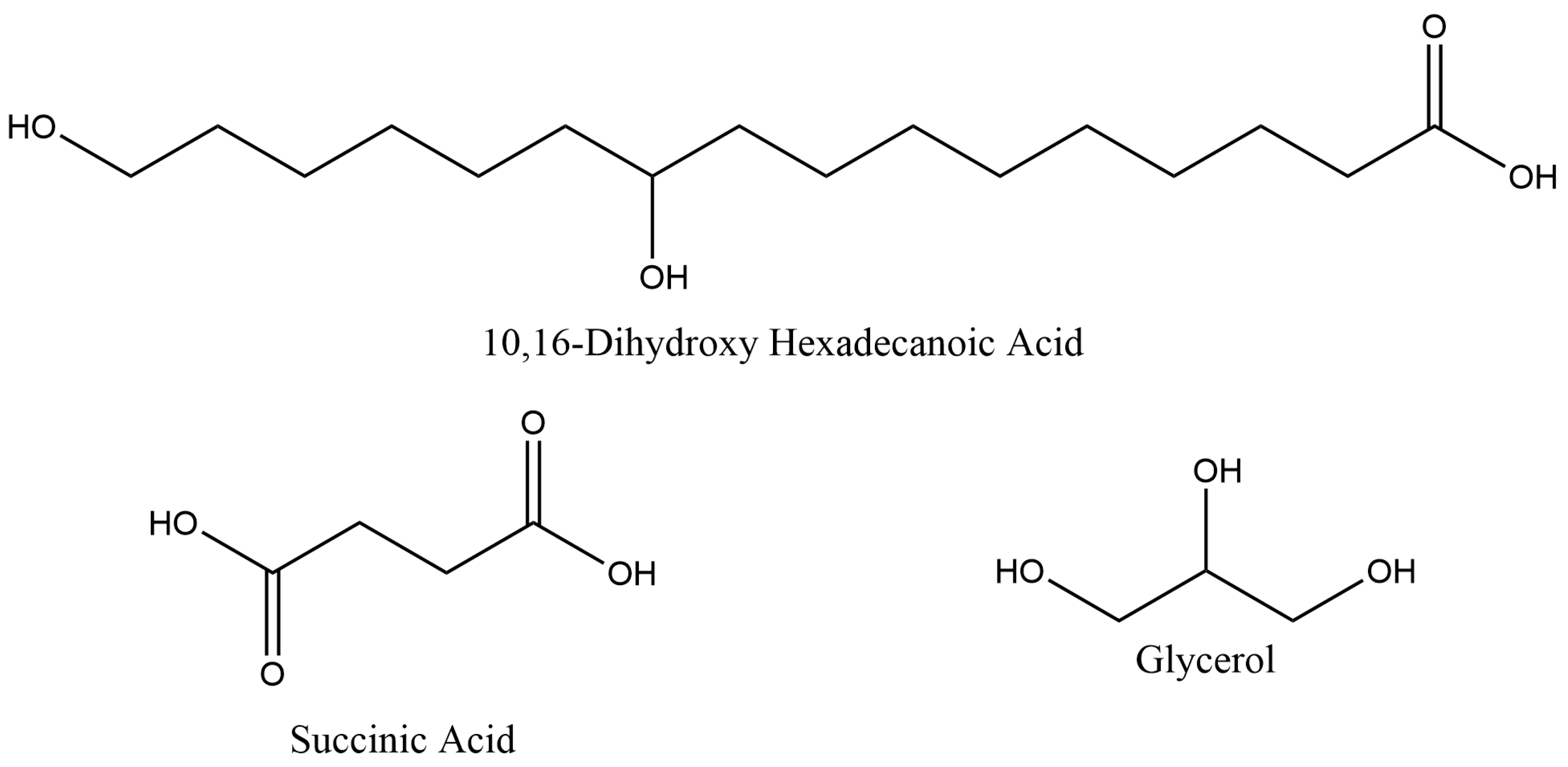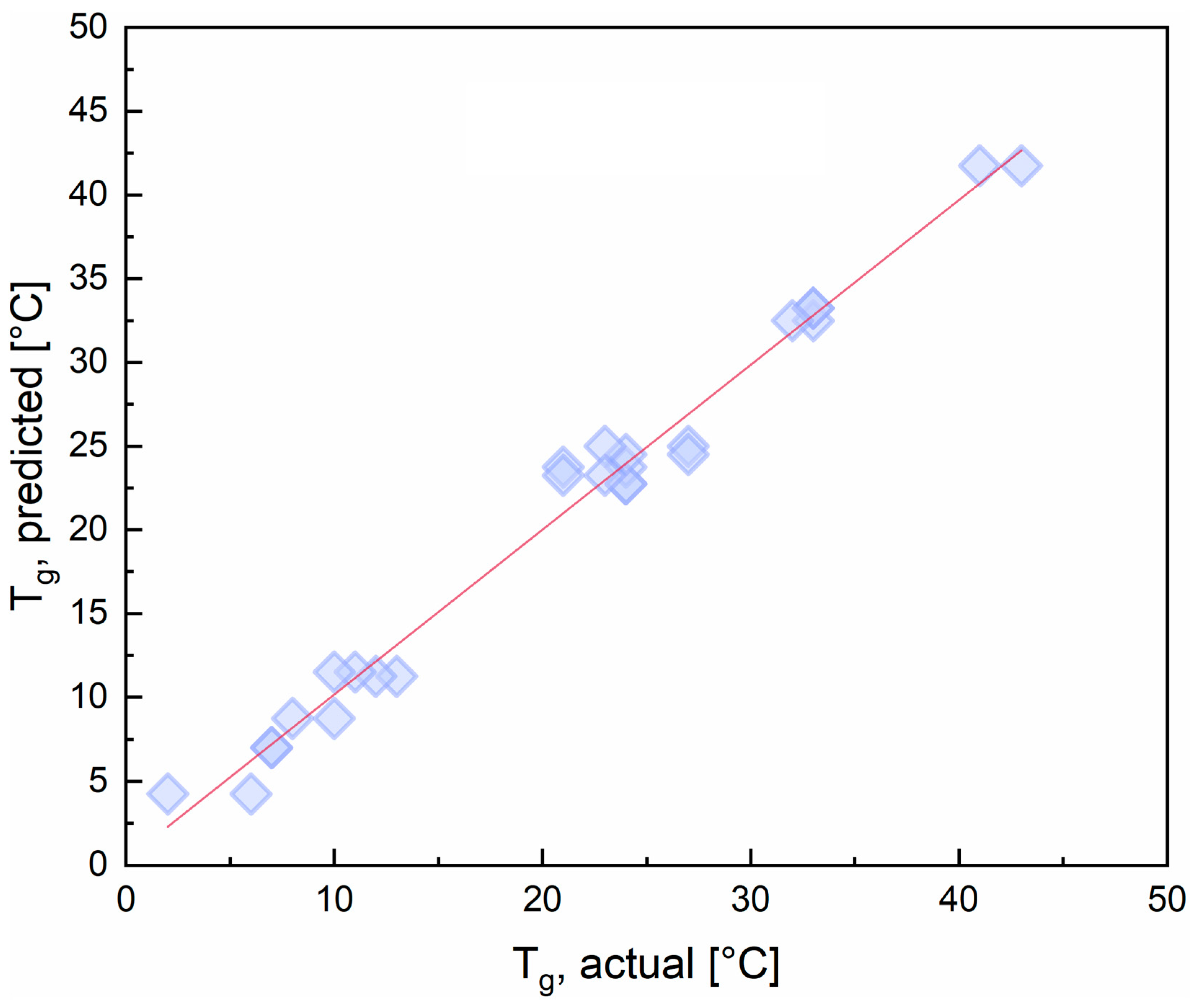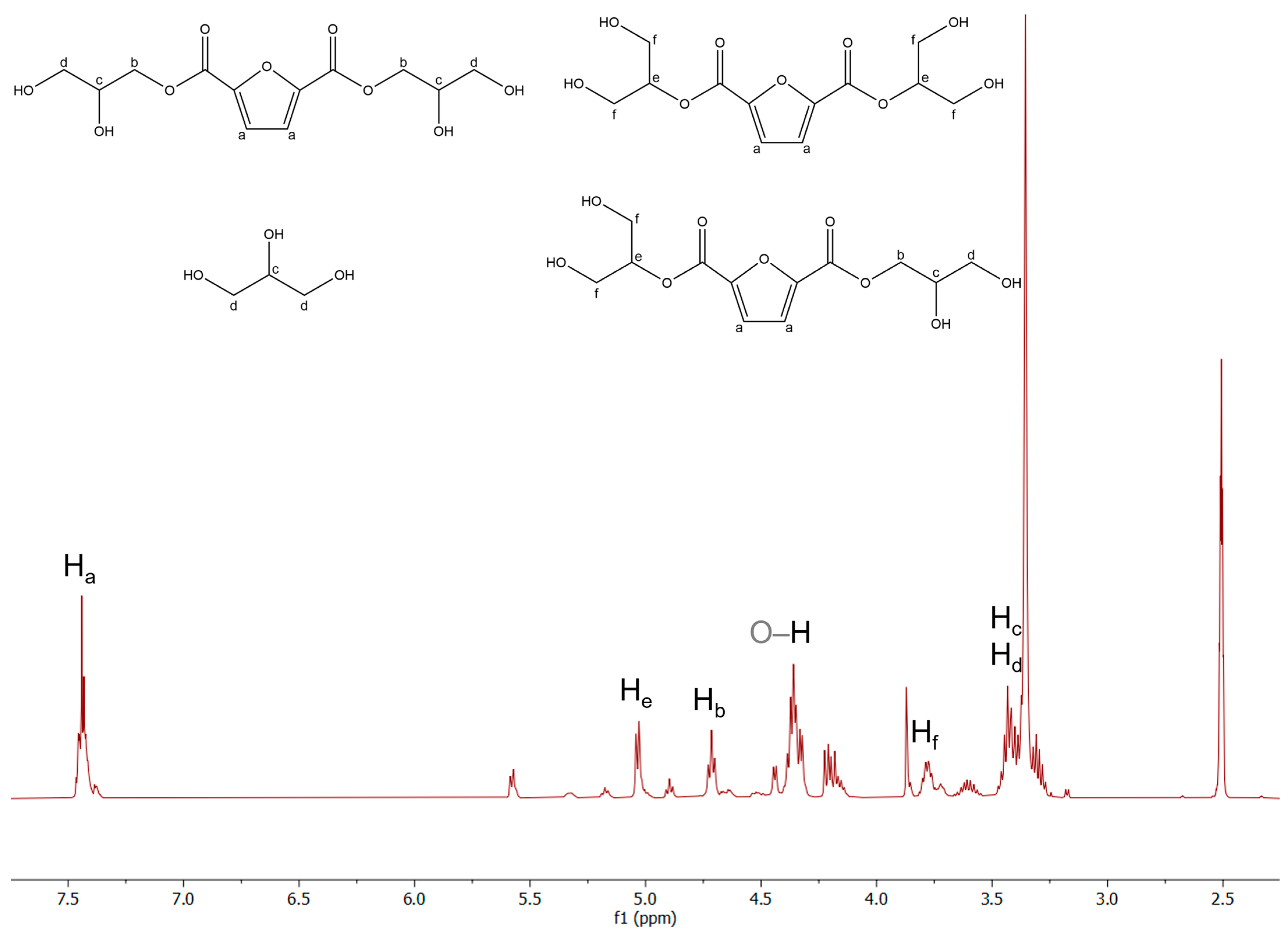Crosslinked Polyesters as Fully Biobased Coatings with Cutin Monomer from Tomato Peel Wastes
Abstract
1. Introduction
2. Materials and Methods
2.1. Materials
2.2. Synthesis Procedures
2.2.1. Cutin Depolymerization and 10,16-Dihydroxyhexadecanoic Acid Isolation
2.2.2. Synthesis of Bis(2,3-Dihydroxypropyl) Furan-2,5-Dicarboxylate Prepolymer
2.2.3. Polyester Resin Formulation and Preparation
2.3. Design of Experiments (DoE)
2.4. Coating Preparation Procedure
2.5. Characterization Techniques
2.5.1. Hydrogen Nuclear Magnetic Resonance (1H-NMR)
2.5.2. Differential Scanning Calorimetry (DSC)
2.5.3. Gel Content Determination
2.5.4. Fourier-Transform Infrared (FTIR) Spectroscopy
2.5.5. Hydroxyl Number Determination
2.5.6. Coating Characterization Tests
3. Results and Discussion
3.1. Cutin Depolymerization and 10,16-diHHDA Recovery
3.2. Cutin-Based Polyester Resins Formulation
3.3. Box–Behnken Design
3.4. Synthesis of the Bis(2,3-Dihydroxypropyl) Furan-2,5-Dicarboxylate Prepolymer
4. Conclusions
Author Contributions
Funding
Institutional Review Board Statement
Data Availability Statement
Acknowledgments
Conflicts of Interest
Appendix A

References
- Domínguez, E.; Heredia-Guerrero, J.A.; Heredia, A. The Biophysical Design of Plant Cuticles: An Overview. New Phytol. 2011, 189, 938–949. [Google Scholar] [CrossRef]
- Heredia, A. Biophysical and Biochemical Characteristics of Cutin, a Plant Barrier Biopolymer. Biochim. Biophys. Acta BBA-Gen. Subj. 2003, 1620, 1–7. [Google Scholar] [CrossRef] [PubMed]
- Chatterjee, S.; Matas, A.J.; Isaacson, T.; Kehlet, C.; Rose, J.K.C.; Stark, R.E. Solid-State 13C NMR Delineates the Architectural Design of Biopolymers in Native and Genetically Altered Tomato Fruit Cuticles. Biomacromolecules 2016, 17, 215–224. [Google Scholar] [CrossRef] [PubMed]
- Cifarelli, A.; Cigognini, I.M.; Bolzoni, L.; Montanari, A. Physical–Chemical Characteristics of Cutin Separated from Tomato Waste for the Preparation of Bio-Lacquers. Adv. Sci. Eng. 2019, 11, 1–33. [Google Scholar] [CrossRef]
- Domínguez, E.; Heredia-Guerrero, J.A.; Heredia, A. Plant Cutin Genesis: Unanswered Questions. Trends Plant Sci. 2015, 20, 551–558. [Google Scholar] [CrossRef]
- España, L.; Heredia-Guerrero, J.A.; Segado, P.; Benítez, J.J.; Heredia, A.; Domínguez, E. Biomechanical Properties of the Tomato (Solanum lycopersicum) Fruit Cuticle during Development Are Modulated by Changes in the Relative Amounts of Its Components. New Phytol. 2014, 202, 790–802. [Google Scholar] [CrossRef]
- Heredia-Guerrero, J.A.; Benítez, J.J.; Domínguez, E.; Bayer, I.S.; Cingolani, R.; Athanassiou, A.; Heredia, A. Infrared and Raman Spectroscopic Features of Plant Cuticles: A Review. Front. Plant Sci. 2014, 5, 305. [Google Scholar] [CrossRef]
- Luque, P.; Bruque, S.; Heredia, A. Water Permeability of Isolated Cuticular Membranes: A Structural Analysis. Arch. Biochem. Biophys. 1995, 317, 417–422. [Google Scholar] [CrossRef]
- Pollard, M.; Beisson, F.; Li, Y.; Ohlrogge, J.B. Building Lipid Barriers: Biosynthesis of Cutin and Suberin. Trends Plant Sci. 2008, 13, 236–246. [Google Scholar] [CrossRef]
- Rock, C.; Yang, W.; Goodrich-Schneider, R.; Feng, H. Conventional and Alternative Methods for Tomato Peeling. Food Eng. Rev. 2012, 4, 1–15. [Google Scholar] [CrossRef]
- World Processing Tomato Council. Available online: https://www.wptc.to/production/ (accessed on 24 January 2024).
- Cifarelli, A.; Cigognini, I.; Bolzoni, L.; Montanari, A. Cutin Isolated from Tomato Processing By-Products: Extraction Methods and Characterization. In Proceedings of the CYPRUS 2016 4th International Conference on Sustainable Solid Waste Management, Limassol, Cyprus, 23–25 June 2016; pp. 1–20. [Google Scholar]
- Taofiq, O.; González-Paramás, A.; Barreiro, M.; Ferreira, I. Hydroxycinnamic Acids and Their Derivatives: Cosmeceutical Significance, Challenges and Future Perspectives, a Review. Molecules 2017, 22, 281. [Google Scholar] [CrossRef]
- Saini, R.K.; Moon, S.H.; Keum, Y.-S. An Updated Review on Use of Tomato Pomace and Crustacean Processing Waste to Recover Commercially Vital Carotenoids. Food Res. Int. 2018, 108, 516–529. [Google Scholar] [CrossRef]
- Heredia-Guerrero, J.A.; Benítez, J.J.; Cataldi, P.; Paul, U.C.; Contardi, M.; Cingolani, R.; Bayer, I.S.; Heredia, A.; Athanassiou, A. All-Natural Sustainable Packaging Materials Inspired by Plant Cuticles. Adv. Sustain. Syst. 2017, 1, 1600024. [Google Scholar] [CrossRef]
- Zhang, B.; Uyama, H. Biomimic Plant Cuticle from Hyperbranched Poly(Ricinoleic Acid) and Cellulose Film. ACS Sustain. Chem. Eng. 2016, 4, 363–369. [Google Scholar] [CrossRef]
- D’Amato, D.; Droste, N.; Allen, B.; Kettunen, M.; Lähtinen, K.; Korhonen, J.; Leskinen, P.; Matthies, B.D.; Toppinen, A. Green, Circular, Bio Economy: A Comparative Analysis of Sustainability Avenues. J. Clean. Prod. 2017, 168, 716–734. [Google Scholar] [CrossRef]
- De Vries, H.; Bredemeijer, G.; Heinen, W. The Decay of Cutin And Cuticular Components By Soil Microorganisms In Their Natural Environment. Acta Bot. Neerlandica 1967, 16, 102–110. [Google Scholar] [CrossRef]
- Katayama, A.; Kuwatsuka, S. Effect of Pesticides on Cellulose Degradation in Soil under Upland and Flooded Conditions. Soil Sci. Plant Nutr. 1991, 37, 1–6. [Google Scholar] [CrossRef]
- Lu, H.; Madbouly, S.A.; Schrader, J.A.; Srinivasan, G.; McCabe, K.G.; Grewell, D.; Kessler, M.R.; Graves, W.R. Biodegradation Behavior of Poly(Lactic Acid) (PLA)/Distiller’s Dried Grains with Solubles (DDGS) Composites. ACS Sustain. Chem. Eng. 2014, 2, 2699–2706. [Google Scholar] [CrossRef]
- Yew, S.-P.; Tang, H.-Y.; Sudesh, K. Photocatalytic Activity and Biodegradation of Polyhydroxybutyrate Films Containing Titanium Dioxide. Polym. Degrad. Stab. 2006, 91, 1800–1807. [Google Scholar] [CrossRef]
- Mark, J.E. (Ed.) Physical Properties of Polymers Handbook; Springer: New York, NY, USA, 2007. [Google Scholar]
- Guzmán-Puyol, S.; Heredia, A.; Heredia-Guerrero, J.A.; Benítez, J.J. Cutin-Inspired Polymers and Plant Cuticle-like Composites as Sustainable Food Packaging Materials. In Sustainable Food Packaging Technology; Athanassiou, A., Ed.; Wiley: Hoboken, NJ, USA, 2021; pp. 161–198. [Google Scholar]
- Benítez, J.J.; Castillo, P.M.; del Río, J.C.; León-Camacho, M.; Domínguez, E.; Heredia, A.; Guzmán-Puyol, S.; Athanassiou, A.; Heredia-Guerrero, J.A. Valorization of Tomato Processing By-Products: Fatty Acid Extraction and Production of Bio-Based Materials. Materials 2018, 11, 2211. [Google Scholar] [CrossRef]
- Kershaw, P.J. Exploring the Potential for Adopting Alternative Materials to Reduce Marine Plastic Litter; UN: New York, NY, USA, 2018. [Google Scholar] [CrossRef]
- Bioplastic Production from Tomato Peel Residues|BIOPROTO Project|Fact Sheet|FP7. Available online: https://cordis.europa.eu/project/id/625297/it (accessed on 24 January 2024).
- Agrimax EU-Funded Project. Available online: https://agrimax-project.eu/ (accessed on 24 January 2024).
- TomaPaint—From Tomato Waste to Natural Paint. Available online: https://www.tomapaint.com/ (accessed on 24 January 2024).
- Tedeschi, G.; Benitez, J.J.; Ceseracciu, L.; Dastmalchi, K.; Itin, B.; Stark, R.E.; Heredia, A.; Athanassiou, A.; Heredia-Guerrero, J.A. Sustainable Fabrication of Plant Cuticle-Like Packaging Films from Tomato Pomace Agro-Waste, Beeswax, and Alginate. ACS Sustain. Chem. Eng. 2018, 6, 14955–14966. [Google Scholar] [CrossRef]
- Heredia-Guerrero, J.A.; Heredia, A.; García-Segura, R.; Benítez, J.J. Synthesis and Characterization of a Plant Cutin Mimetic Polymer. Polymer 2009, 50, 5633–5637. [Google Scholar] [CrossRef]
- Benítez, J.J.; Heredia-Guerrero, J.A.; Guzmán-Puyol, S.; Barthel, M.J.; Domínguez, E.; Heredia, A. Polyhydroxyester Films Obtained by Non-Catalyzed Melt-Polycondensation of Natural Occurring Fatty Polyhydroxyacids. Front. Mater. 2015, 2, 59. [Google Scholar] [CrossRef]
- Arnich, N.; Canivenc-Lavier, M.-C.; Kolf-Clauw, M.; Coffigny, H.; Cravedi, J.-P.; Grob, K.; Macherey, A.-C.; Masset, D.; Maximilien, R.; Narbonne, J.-F.; et al. Conclusions of the French Food Safety Agency on the Toxicity of Bisphenol A. Int. J. Hyg. Environ. Health 2011, 214, 271–275. [Google Scholar] [CrossRef]
- Carwile, J.L. Canned Soup Consumption and Urinary Bisphenol A: A Randomized Crossover Trial. JAMA 2011, 306, 2218. [Google Scholar] [CrossRef]
- LaKind, J.S.; Naiman, D.Q. Daily Intake of Bisphenol A and Potential Sources of Exposure: 2005–2006 National Health and Nutrition Examination Survey. J. Expo. Sci. Environ. Epidemiol. 2011, 21, 272–279. [Google Scholar] [CrossRef]
- Rudel, R.A.; Gray, J.M.; Engel, C.L.; Rawsthorne, T.W.; Dodson, R.E.; Ackerman, J.M.; Rizzo, J.; Nudelman, J.L.; Brody, J.G. Food Packaging and Bisphenol A and Bis(2-Ethyhexyl) Phthalate Exposure: Findings from a Dietary Intervention. Environ. Health Perspect. 2011, 119, 914–920. [Google Scholar] [CrossRef]
- Vandenberg, L.N.; Hauser, R.; Marcus, M.; Olea, N.; Welshons, W.V. Human Exposure to Bisphenol A (BPA). Reprod. Toxicol. 2007, 24, 139–177. [Google Scholar] [CrossRef] [PubMed]
- Bisphenol A (BPA) Market Size, Growth & Forecast, 2032. Available online: https://www.chemanalyst.com/industry-report/bisphenol-a-market-57 (accessed on 24 January 2024).
- Epoxy Resin Market Size & Share Analysis—Growth Trends & Forecasts (2024–2029). Available online: https://www.mordorintelligence.com/industry-reports/global-epoxy-resin-market-industry (accessed on 24 January 2024).
- Righetti, G.I.C.; Nasti, R.; Beretta, G.; Levi, M.; Turri, S.; Suriano, R. Unveiling the Hidden Properties of Tomato Peels: Cutin Ester Derivatives as Bio-Based Plasticizers for Polylactic Acid. Polymers 2023, 15, 1848. [Google Scholar] [CrossRef]
- Zhao, D.; Delbecq, F.; Len, C. One-Pot FDCA Diester Synthesis from Mucic Acid and Their Solvent-Free Regioselective Polytransesterification for Production of Glycerol-Based Furanic Polyesters. Molecules 2019, 24, 1030. [Google Scholar] [CrossRef] [PubMed]
- Marc, M.; Risani, R.; Desnoes, E.; Falourd, X.; Pontoire, B.; Rodrigues, R.; Escórcio, R.; Batista, A.P.; Valentin, R.; Gontard, N.; et al. Bioinspired Co-Polyesters of Hydroxy-Fatty Acids Extracted from Tomato Peel Agro-Wastes and Glycerol with Tunable Mechanical, Thermal and Barrier Properties. Ind. Crops Prod. 2021, 170, 113718. [Google Scholar] [CrossRef]
- Prakash Maran, J.; Sivakumar, V.; Sridhar, R.; Prince Immanuel, V. Development of Model for Mechanical Properties of Tapioca Starch Based Edible Films. Ind. Crops Prod. 2013, 42, 159–168. [Google Scholar] [CrossRef]
- Hamed, E.; Sakr, A. Application of Multiple Response Optimization Technique to Extended Release Formulations Design. J. Control. Release 2001, 73, 329–338. [Google Scholar] [CrossRef] [PubMed]
- Prakash Maran, J.; Manikandan, S. Response Surface Modeling and Optimization of Process Parameters for Aqueous Extraction of Pigments from Prickly Pear (Opuntia ficus-indica) Fruit. Dyes Pigm. 2012, 95, 465–472. [Google Scholar] [CrossRef]
- E222-00; Standard Test Methods for Hydroxyl Groups Using Acetic Anhydride Acetylation. ASTM International: West Conshohocken, PA, USA, 2000.
- D3363-05; Standard Test Method for Film Hardness by Pencil Test. ASTM International: West Conshohocken, PA, USA, 2005.
- D4752-20; Standard Practice for Measuring MEK Resistance of Ethyl Silicate (Inorganic) Zinc-Rich Primers by Solvent Rub. ASTM International: West Conshohocken, PA, USA, 2020.
- Davidson, M.G.; Elgie, S.; Parsons, S.; Young, T.J. Production of HMF, FDCA and Their Derived Products: A Review of Life Cycle Assessment (LCA) and Techno-Economic Analysis (TEA) Studies. Green Chem. 2021, 23, 3154–3171. [Google Scholar] [CrossRef]






| Levels | Factors | ||
|---|---|---|---|
| 10,16-diHHDA [mol] | Glycerol [mol] | OH/COOH Molar Ratio | |
| −1 | 0.5 | 1 | 0.75 |
| 0 | 1 | 2.5 | 1 |
| +1 | 1.5 | 4 | 1.25 |
| Std. Order | 10,16-diHHDA [mol] | Glycerol [mol] | OH/COOH Molar Ratio |
|---|---|---|---|
| 1 | 0.5 (−1) | 1 (−1) | 1 (0) |
| 2 | 1.5 (+1) | 1 (−1) | 1 (0) |
| 3 | 0.5 (−1) | 4 (+1) | 1 (0) |
| 4 | 1.5 (+1) | 4 (+1) | 1 (0) |
| 5 | 0.5 (−1) | 2.5 (0) | 0.75 (−1) |
| 6 | 1.5 (+1) | 2.5 (0) | 0.75 (−1) |
| 7 | 0.5 (−1) | 2.5 (0) | 1.25 (+1) |
| 8 | 1.5 (+1) | 2.5 (0) | 1.25 (+1) |
| 9 | 1 (0) | 1 (−1) | 0.75 (−1) |
| 10 | 1 (0) | 4 (+1) | 0.75 (−1) |
| 11 | 1 (0) | 1 (−1) | 1.25 (+1) |
| 12 | 1 (0) | 4 (+1) | 1.25 (+1) |
| 13 | 1 (0) | 2.5 (0) | 1 (0) |
| Coating Components | Weight Fractions [%] | Molar Fractions [%] | Tg [°C] | Gel Content [%] |
|---|---|---|---|---|
| 10,16-diHHDA | 75 | 67 | −11 | 92 |
| CA | 25 | 33 | ||
| 10,16-diHHDA | 83 | 67 | −7 | 94 |
| SA | 17 | 33 | ||
| 10,16-diHHDA | 38 | 19 | 33 | 98 |
| SA | 43 | 52 | ||
| Gly | 18 | 29 | ||
| 10,16-diHHDA | 33 | 15 | 35 | 99 |
| SA | 47 | 54 | ||
| Gly | 21 | 31 | ||
| 10,16-diHHDA | 25 | 11 | 43 | 98 |
| SA | 51 | 56 | ||
| Gly | 24 | 33 |
| Source | DF | Adj SS | Adj MS | F-Value | p-Value |
|---|---|---|---|---|---|
| Model | 9 | 3135.62 | 348.40 | 112.61 | 0.000 |
| = 0.992 | = 0.985 | = 0.975 | |||
| Run No. | 10,16-diHHDA [mol] | Glycerol [mol] | OH/COOH Molar Ratio | Tg, Actual [°C] | Tg, Predicted [°C] | 10,16-diHHDA Weight Fraction [%] |
|---|---|---|---|---|---|---|
| Simulation 1 a | 0.5 | 6 | 1 | 48 | 50.13 | 8 |
| 47 | ||||||
| 16 | 0.5 | 4 | 1 | 43 | 41.75 | 12 |
| 3 | 0.5 | 4 | 1 | 41 | 41.75 | 12 |
| 7 | 0.5 | 2.5 | 1.25 | 33 | 32.50 | 19 |
| 12 | 1 | 4 | 1.25 | 33 | 33.25 | 23 |
| 25 | 1 | 4 | 1.25 | 33 | 33.25 | 23 |
| 20 | 0.5 | 2.5 | 1.25 | 32 | 32.50 | 19 |
| 13 | 1 | 2.5 | 1 | 27 | 25.00 | 32 |
| 5 b | 0.5 | 2.5 | 0.75 | 27 | 24.50 | 14 |
| 4 | 1.5 | 4 | 1 | 24 | 25.00 | 27 |
| 14 | 0.5 | 1 | 1 | 24 | 24.50 | 33 |
| 17 | 1.5 | 4 | 1 | 24 | 22.75 | 27 |
| 18 b | 0.5 | 2.5 | 0.75 | 24 | 24.50 | 14 |
| 26 | 1 | 2.5 | 1 | 23 | 25.00 | 32 |
| 10 b | 1 | 4 | 0.75 | 23 | 23.25 | 17 |
| 1 | 0.5 | 1 | 1 | 21 | 23.75 | 33 |
| 23 b | 1 | 4 | 0.75 | 21 | 23.25 | 17 |
| 11 | 1 | 1 | 1.25 | 13 | 11.25 | 52 |
| 24 | 1 | 1 | 1.25 | 12 | 11.25 | 52 |
| 8 | 1.5 | 2.5 | 1.25 | 11 | 11.50 | 40 |
| 21 | 1.5 | 2.5 | 1.25 | 10 | 11.50 | 40 |
| 9 b | 1 | 1 | 0.75 | 10 | 8.75 | 41 |
| 22 b | 1 | 1 | 0.75 | 8 | 8.75 | 41 |
| 19 b | 1.5 | 2.5 | 0.75 | 7 | 7.00 | 31 |
| 6 b | 1.5 | 2.5 | 0.75 | 7 | 7.00 | 31 |
| 15 | 1.5 | 1 | 1 | 6 | 4.25 | 55 |
| 2 | 1.5 | 1 | 1 | 2 | 4.25 | 55 |
| Simulation 2 | 1.5 | 1 | 1.25 | 5 | −0.44 | 60 |
| 1 |
| Resin Components | Weight Fractions [%] | –OH Fraction from 10,16-diHHDA [%] | –COOH Fraction from 10,16-diHHDA [%] | Tg [°C] | Gel Content [%] |
|---|---|---|---|---|---|
| 10,16-diHHDA | 48 | 50 | 31 | 41 | 100 |
| FDCA prepolymer | 31 | ||||
| SA | 21 | ||||
| 10,16-diHHDA | 39 | 40 | 25 | 54 | 100 |
| FDCA prepolymer | 38 | ||||
| SA | 23 | ||||
| 10,16-diHHDA | 28 | 29 | 18 | 53 | 100 |
| FDCA prepolymer | 45 | ||||
| SA | 27 | ||||
| 10,16-diHHDA | 7 | 8 | 4 | 83 | 100 |
| FDCA prepolymer | 56 | ||||
| SA | 37 |
| Coating Components | Weight Fractions [%] | Thickness [µm] | Water Contact Angle [°] | Pencil Hardness | MEK Test [Double Rubs] | Pull-Off Strength [MPa] |
|---|---|---|---|---|---|---|
| 10,16-diHHDA | 39 | 42 | 101 ± 1 | HB | >100 | >2.15 |
| FDCA prepolymer | 38 | |||||
| SA | 23 | |||||
| 10,16-diHHDA | 48 | 44 | 100 ± 1 | HB | >100 | >2.20 |
| FDCA prepolymer | 31 | |||||
| SA | 21 |
Disclaimer/Publisher’s Note: The statements, opinions and data contained in all publications are solely those of the individual author(s) and contributor(s) and not of MDPI and/or the editor(s). MDPI and/or the editor(s) disclaim responsibility for any injury to people or property resulting from any ideas, methods, instructions or products referred to in the content. |
© 2024 by the authors. Licensee MDPI, Basel, Switzerland. This article is an open access article distributed under the terms and conditions of the Creative Commons Attribution (CC BY) license (https://creativecommons.org/licenses/by/4.0/).
Share and Cite
Ruffini, E.; Bianchi Oltolini, A.; Magni, M.; Beretta, G.; Cavallaro, M.; Suriano, R.; Turri, S. Crosslinked Polyesters as Fully Biobased Coatings with Cutin Monomer from Tomato Peel Wastes. Polymers 2024, 16, 682. https://doi.org/10.3390/polym16050682
Ruffini E, Bianchi Oltolini A, Magni M, Beretta G, Cavallaro M, Suriano R, Turri S. Crosslinked Polyesters as Fully Biobased Coatings with Cutin Monomer from Tomato Peel Wastes. Polymers. 2024; 16(5):682. https://doi.org/10.3390/polym16050682
Chicago/Turabian StyleRuffini, Eleonora, Andrea Bianchi Oltolini, Mirko Magni, Giangiacomo Beretta, Marco Cavallaro, Raffaella Suriano, and Stefano Turri. 2024. "Crosslinked Polyesters as Fully Biobased Coatings with Cutin Monomer from Tomato Peel Wastes" Polymers 16, no. 5: 682. https://doi.org/10.3390/polym16050682
APA StyleRuffini, E., Bianchi Oltolini, A., Magni, M., Beretta, G., Cavallaro, M., Suriano, R., & Turri, S. (2024). Crosslinked Polyesters as Fully Biobased Coatings with Cutin Monomer from Tomato Peel Wastes. Polymers, 16(5), 682. https://doi.org/10.3390/polym16050682









